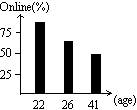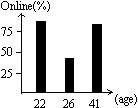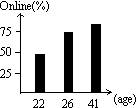阅读短文,完成问题。
Happiness and sadness are states of being that define the way we view the world. It is often said that some people by nature have a sunny character. Now scientists may have discovered why.
Some people may be born for happiness, while others are genetically negative, scientists have suggested in a study published late February in a British journal.
Earlier research had already established that the gene known as 5-HTTLPR plays a key role in determining how the neurotransmitter (神经传递素) serotonin (含于血液中的复合胺) works within the brain. Serotonin, a hormone (荷尔蒙), passes chemical messages between nerve cells. It has been closely linked to mood. Several anti-depressant (抗抑郁) drugs regulate serotonin levels. Scientists had also identified three variants (变体) of the gene. Two so-called "short" variants were linked to a higher risk of depression and suicide attempts. Unlike the two "short" variants, the "long" variant of 5-HTTLPR showed a clear dislike of negative images, such as fierce animals, and a clear liking for positive ones, such as flowers.
Researchers from the University of Essex in Britain, led by Elaine Fox, showed participants a series of images. The images were divided into three kinds: negative ones aimed at inspiring fear or stress such as a spider or person about to commit suicide, pleasant ones and neutral (中性的) ones. The participants who had the long variant of the 5-HTTLPR gene "showed a clear dislike of negative material alongside a careful attention for positive material," the researchers found. They paid close attention to the pretty pictures, and ignored the frightening ones. On the other hand, the short variant groups had the opposite reaction.
In January, the Australian government organized "happiness workshops", teaching government staff how to be happy. The department that held the "happiness workshops" said unhappy staff weren't productive staff. Australian political opposition parties have argued that the "happiness workshops" are probably a waste of money and couldn't increase productivity as intended. However, whether the workshop will have a happy or disappointing result, we will have to wait and see.
1. For the passage,by what means can we view the world?
A. Happiness and sadness. B. Happiness and curiosity.
C. Sadness and amazement. D. Disappointment and sadness.
2. What is most important in the role of deciding how the the neurotransmitter serotonin works within the brain?
A. The gene known as 5-HTTLPR. B. Three variants.
C. Neurotransmitter serotonin . D. A hormone.
3 Which of the following sentences is WRONG?
A. Serotonin, a hormone within the brain., passes chemical messages between nerve cells, which has been closely linked to mood.
B. Scientists identified the two "short" variants, and the "long" variant of 5-HTTLPR which showed a clear hatred of negative images, such as fierce animals.
C. Scientists identified three variants of the gene. Two so-called "long" variants were linked to a higher risk of depression and murder attempts.
D. In terms of researchers’ research, the images were divided into three kinds: negative ones, pleasant ones and neutral ones.
4. Why did the Australian government organize “Happiness workshops”?
A. To enrich staff’s free life.
B. To teach staff the ways to be happy.
C. To prove the result of the researchers’ research.
D. To test who weren’t productive staff.
5. What is the

result of setting up “Happiness workshops” according to the last paragraph?
A. A waste of money.
B. No effect on increasing productivity.
C. A disappointing result .
D. An uncertain result.

 小学夺冠AB卷系列答案
小学夺冠AB卷系列答案 ABC考王全优卷系列答案
ABC考王全优卷系列答案 B.
B.
 D.
D. 
 result of setting up “Happiness workshops” according to the last paragraph?
result of setting up “Happiness workshops” according to the last paragraph?